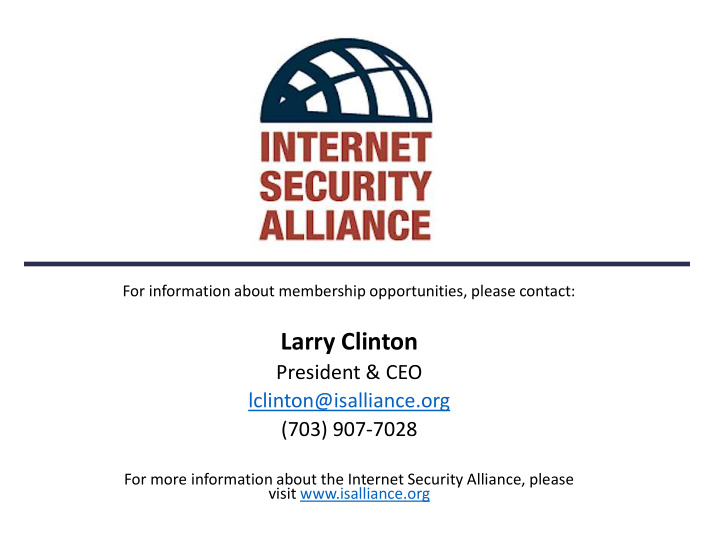



For information about membership opportunities, please contact: Larry Clinton President & CEO lclinton@isalliance.org (703) 907-7028 For more information about the Internet Security Alliance, please visit www.isalliance.org
Digitalization Changes Everything • The way our brains function • The way we define ourselves • Our notions of what privacy is • Our assumptions about how to conduct national defense • Our assumptions about economics • Our assumptions about security 3
How confident are you (should you be)? • 80% of CEOs are “very confident” – but successful compromises up 66% • Losses will jump from $500 billion to $2 trillion by 2018 – up 2x as much as security spending • 71% of attacks are on firms w/less than $2 billion • CEOs still prioritize keeping the bad guys out • CEOs agree they need better ways to measure success 4
Benchmarking DoD --- Things are really bad The military’s computer networks can be compromised by low to middling skilled attacks. Military systems do not have a sufficiently robust security posture to repel sustained attacks. The development of advanced cyber techniques makes it likely that a determined adversary can acquire a foothold in most DOD systems and be in a position to degrade DOD missions when and if they choose .” Pentagon Annual Report Jan 2015. 5
Things are going to get worse … • The attackers are getting much better • All the economic incentives favor the attackers • The system is getting technologically weaker 6
Kremlinology
Trumpology Lt. Gen. Michael Flynn National Security Advisor Steven Bannon Donald McGahn General Counsel General Keith Kellogg National Security Council Gen. James Mattis Sec of Dep. of Defense Mike Pence Vice President Tom Bossert Homeland Security Advisor President Donald Trump Gen. John Kelly (USMC – Ret.) Sec of Dep. of Homeland Security Josh Steinman Karen Evans Adm. Mike Rogers Rudy Guiliani Governor Rick Perry Director of National Former Mayor of NYC Sec. of Dep. of Energy Intelligence
Cybersecurity in the Power Utilities Sector 1. Enhance information sharing between utilities and the federal government. 2. Reforming the clearance-attainment process for private-sector executives. 3. Ensure DoE remains the primary liaison between utilities and the federal government. 4. Catalyze and accelerate the development of the private cybersecurity insurance market. 5. Promote innovation through government grants. 9
Cybersecurity in the Power Utilities Sector 6. Increase cybersecurity focus of state-level regulators and legislatures. 7. Encourage public-private collaboration to manage vendor risks. 10
Necessary Steps for Small and Medium-Sized Organizations 1. Have an information security policy. 2. Patch your systems and applications, and probably do it automatically. 3. Require multi-factor authentication. 4. Restrict employee’s ability to surf the web on company computers. 5. Train employees on cybersecurity practices. 6. Scan and filter email and web traffic. 7. Set up logging and store the data for the long-term 11
ISA/NACD Cyber-Risk Oversight Handbook Copies of the ISA/NACD Cyber-Risk Oversight Handbook can be obtained at: http://www.isalliance.org/ cyber-risk-handbook 12
Corporate Boards are getting involved • Guidelines from the NACD advise that Boards should view cyber-risks from an enterprise- wide standpoint and understand the potential legal impacts. They should discuss cybersecurity risks and preparedness with management, and consider cyber threats in the context of the organization’s overall tolerance for risk. -- PWC 2016 Global Information Security Survey 13
Boards are taking action • Boards appear to be listening to this advice. This year we saw a double-digit uptick in Board participation in most aspects of information security. Deepening Board involvement has improved cybersecurity practices in numerous ways. As more Boards participate in cybersecurity budget discussions, we saw a 24% boost in security spending. --- PWC 2016 Global Information Security Survey 14
Actual Cyber Security Improvements • Notable outcomes cited by survey respondents include identification of key risks, fostering an organizational culture of security and better alignment of cybersecurity with overall risk management and business goals. Perhaps more than anything, Board participation opened the lines of communication between the cybersecurity function and top executives and directors -- PWC 2016 Global Information Security Survey 15
ISA Comments to CAQ 1. These proposed engagements are assessments, not audits. 2. Measuring cyber assessments should use a maturity model. 3. Cybersecurity is not all about “IT”. 4. Assessment tools need to focus primarily on techniques with proven effectiveness and cost effectiveness. 5. The assessment tool needs to be a voluntary model – really voluntary. 6. We need to assure there will be adequate Talent Availability to perform the assessments. 16
Recommend
More recommend